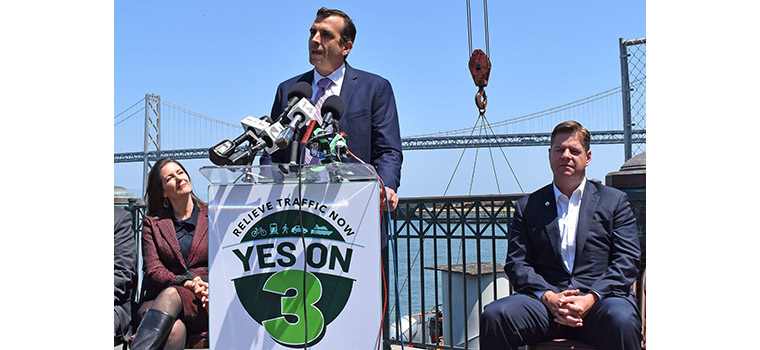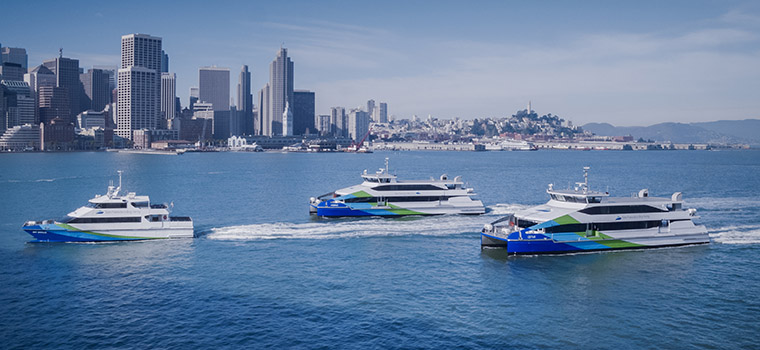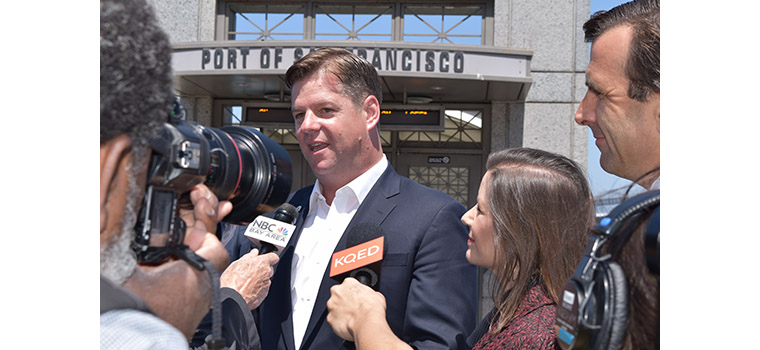Last month, mayors Mark Farrell, Libby Schaaf and Sam Liccardo joined forces at the San Francisco Ferry Building and called for voter action in support of Regional Measure 3 (RM3)-a June 5 ballot measure that will bring significant transit improvements and traffic congestion relief to the Bay Area.

San Jose Mayor Sam Liccardo (center) addresses a crowd at the San Francisco Ferry Building in support of RM3. He was joined by Oakland Mayor Libby Schaaf (left) and San Francisco Mayor Mark Farrell (right). Photo by Joel Williams
BC STAFF REPORT
Last month, mayors Mark Farrell, Libby Schaaf and Sam Liccardo joined forces at the San Francisco Ferry Building and called for voter action in support of Regional Measure 3 (RM3)—a June 5 ballot measure that will bring significant transit improvements and traffic congestion relief to the Bay Area. The successful passage of RM3 will provide a major investment to fund crucial transportation infrastructure projects that ease traffic on area roadways and increase transit capacity and efficiency across the region.
“Regional Measure 3 is not only a major local investment that is critical, but also an opportunity for cities and counties in the Bay Area to work together and take a regional approach to addressing traffic congestion that is widespread throughout the Bay Area,” said San Francisco Mayor Mark Farrell. “RM3 is an investment in the future of our transportation network, economic growth and our quality of life in the Bay Area.”
The Silicon Valley Leadership Group, Bay Area Council, SPUR, the Metropolitan Transportation Commission and over 625 elected officials, community organizations and community leaders have united in support of RM3’s plan to reduce traffic congestion—one of the greatest threats to the economic vitality of the region.
“It is no secret that our current transportation infrastructure is strapped,” said Oakland Mayor Libby Schaaf. “Regional Measure 3 provides a direct path to implement badly needed improvements that have been prioritized by local authorities from the nine counties to make our public transit options, roadways and transit corridors, and pedestrian and bike paths more reliable and efficient.”
Year after year, in good economic times and bad, Bay Area residents rank transportation as one of their highest priorities—a recent survey named it the second most pressing issue behind housing. Along with support for projects that ease congestion, polled voters show strong support for reducing truck traffic and air pollution and expanding transit networks while improving access, comfort and convenience for riders—all key elements addressed by RM3.
“Regional Measure 3 will fund crucial transportation and traffic relief projects that are imperative for the future of the entire Bay Area,” said San Jose Mayor Sam Liccardo. “Residents across the region suffer daily due to our dreadful traffic congestion and aging transportation infrastructure, and with the likelihood for federal transportation funds shrinking, we must invest in initiatives that will help get our region moving again.”
Voters have proven time and again their support for critical transit and traffic relief initiatives, including through the passage of Regional Measure 1 (RM1) in 1988 and Regional Measure 2 (RM2) in 2004. These measures raised tolls on the Bay Area’s seven state-owned toll bridges and delivered dozens of the most important transportation investments of the past generation.
Funds obtained through the passage of RM1 in 1988 paid for projects like the new Benicia-Martinez Bridge, which opened in 2007, virtually eliminating the long backups that plagued the northbound interstate 680 approach in Costa Contra County. Other projects funded through RM1 include the Richmond Parkway, San Mateo-Hayward Bridge widening, the new Alfred Zampa Memorial Bridge across the Carquinez Strait, widening of the Bayfront Expressway in San Mateo County, and rehab work on both the Richmond-San Rafael Bridge and the original 1962 Benicia-Martinez Bridge. And State Route 92 fell from the list of most congested Bay Area freeways following completion of a Regional Measure 1 project to replace its interchange with Interstate 880 near the approach to the San Mateo Bridge which was also widened in 2003 with those same funds.
Projects funded through the passage of RM2 in 2004 included the new South San Francisco ferry expansion; the long-needed Caldecott Tunnel fourth bore project and San Francisco’s Third Street light rail project, which provides faster and more reliable connections between downtown and the city’s southeastern neighborhoods.
Other projects funded through RM2 include San Francisco’s Central Subway, Interstate 80/680 interchange upgrades in Solano County, State Route 4 widening in eastern Contra Costa County, the e-BART extension to Pittsburg and Antioch, seismic retrofit of the BART Transbay Tube, the Transbay Transit Center now under construction in San Francisco, and BART’s extension from Fremont to Warm Springs, which opened earlier this year.
The 2014 completion of the BART connection to Oakland International Airport was also made possible by more than $140 million of RM2 funding, which also provides ongoing operating support for the Clipper transit-fare payment card, and for key bus, ferry and light-rail services around the region.
Voter approval of RM3 would raise tolls on the region’s state-owned toll bridges by $1 beginning January 1 of next year. Tolls would rise by another $1 in January 2022 with another $1 increase in January 2025. This would mark the first toll increase on the seven state-owned bridges since 2010. The Golden Gate Bridge is owned by a separate authority and would not be a part of the increase.
If approved by a majority of voters in Alameda, Contra Costa, Marin, Napa, San Francisco, San Mateo, Santa Clara, Solano and Sonoma counties, increased toll revenues would be used to finance a $4.45 billion slate of highway and transit improvements in the toll bridge corridors and their approach routes.
RM3 stipulates that funding will be allocated to projects that have an urgent need for funding and was developed from a list of improvement projects based on priorities by voters in each of the Bay Area’s nine counties.
Major projects include expansion of BART’s railcar fleet to accommodate record ridership and the system’s pending 2018 extension to Milpitas and East San Jose; further extension of BART’s Silicon Valley service to downtown San Jose and Santa Clara; extending Caltrain to downtown San Francisco; expanding transbay bus services and AC Transit’s bus rapid transit lines; constructing a direct freeway connector from northbound U.S. 101 to eastbound Interstate 580 in Marin County, and improving the westbound approach to the Richmond-San Rafael Bridge and the I-580/Richmond Parkway interchange in Contra Costa County; constructing a direct connector between Interstates 680 and 880 in Fremont; upgrading the I-680/State Route 4 interchange in Contra Costa County, the I-680/State Route 84 interchange in Alameda County and the U.S. 101/State Route 92 interchange in San Mateo; various upgrades to relieve congestion in the Dumbarton Bridge corridor and improve State Route 37 in Marin, Sonoma, Napa and Solano counties; and extending the new SMART rail system to Windsor and Healdsburg and expanding San Francisco’s fleet of Muni Metro rail cars. The bill also includes a $150 million grant program to improve bicycle and pedestrian access to regional transit hubs and to close gaps in the San Francisco Bay Trail.
But probably most important to Bay Crossings readers, the measure would provide WETA with $300 million for capital projects and up to $35 million in annual operating expenses. WETA would use RM3 funds to build new vessels and terminals, enhance service on existing routes and launch service to new locations including Berkeley, San Francisco’s Mission Bay and Redwood City.
So we urge you to show up at your local polling place on June 5 and vote in favor of RM3. The future of your commute could depend on it!

Regional Measure 3 would provide WETA with $300 million for capital projects and up to $35 million in annual operating expenses. WETA would use these funds to build new vessels and terminals, enhance service on existing routes and launch service to new locations. Photo by Toby Harriman Photography

San Francisco Mayor Mark Farrell fields questions from reporters on Regional Measure 3. Photo by Joel Williams

